- home
- BAKERECIPES
BakeRecipes
Bringing real baking into your home with deliciously simple recipes.
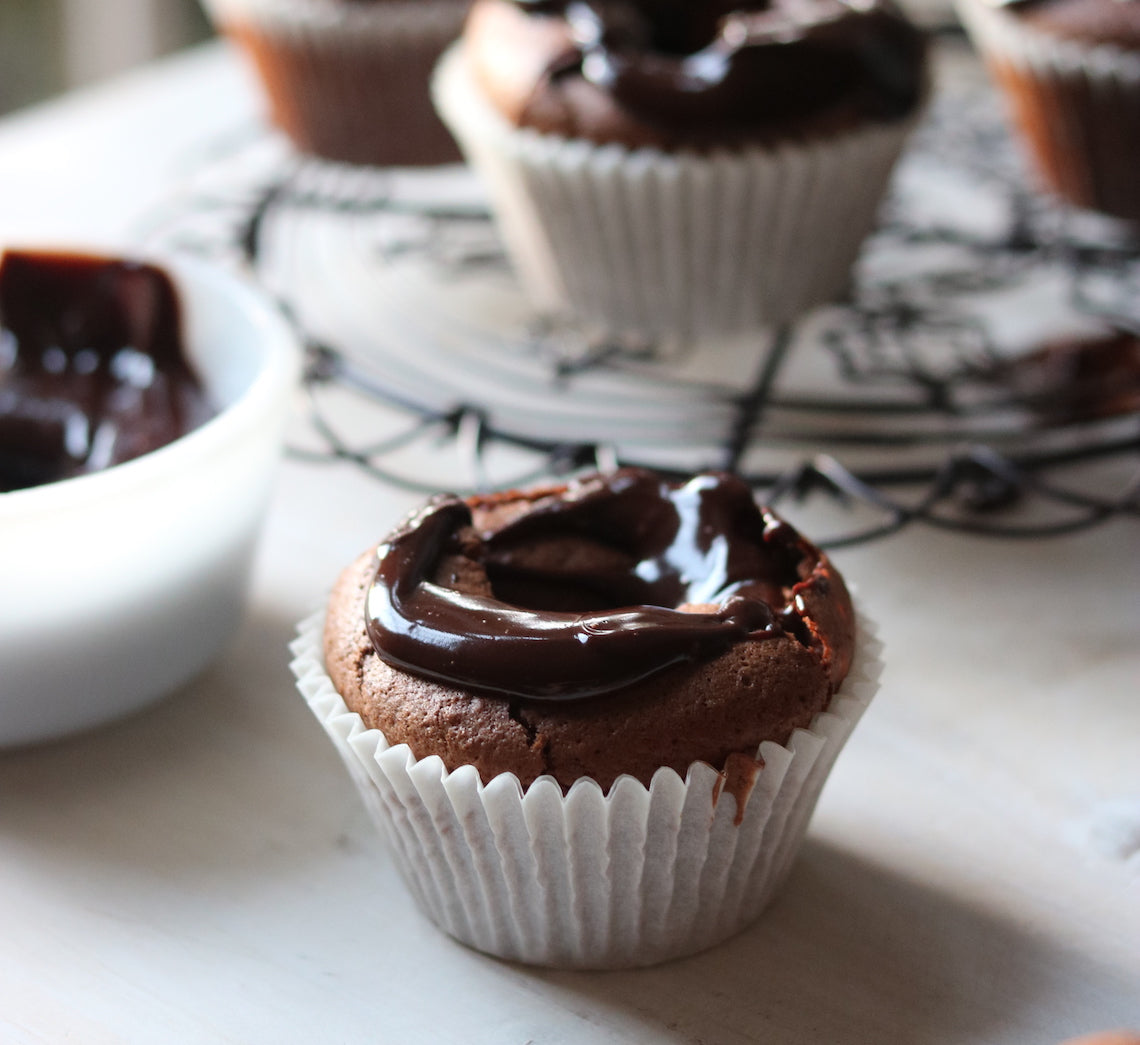
Prep 25minBake 30-35minMakes 12
Drizzled with an oozing chocolate ganache, these cupcakes are wickedly rich (but light in texture) and have a surprise of intense raspberry tartness hidden right in the middle!
Don't worry, you haven't done anything wrong – these cupcakes are meant to have a hole in the centre... Because the mixture is flourless, the raspberry jam sinks during baking creating a crater of sorts, giving them their name.
Ingredients
180g good-quality dark chocolate (45% or 70% cocoa), chopped (see Baker's Tips)
125g butter, cubed
60ml (1/4 cup) water
220g (1 cup) brown sugar, plus 2 tablespoons extra
85g (3/4 cup) hazelnut meal
25g (1/4 cup) desiccated coconut
3 eggs, at room temperature, separated
85g (1/4 cup) raspberry jam
Chocolate ganache
180g good-quality dark chocolate (45% cocoa), finely chopped
60ml (1/4 cup) pure (pouring) cream
Method
- Preheat the oven to 180°C (160°C fan-forced). Line a 12-hole 80ml (⅓ cup) muffin tin with paper cases.
- Combine the chocolate, butter and water in a medium saucepan and stir over a low heat until melted and smooth. Remove from heat, add the sugar, hazelnut meal, coconut and egg yolks and stir well with a wooden spoon until well combined and any lumps have broken up. Transfer the mixture to a large bowl.
- Place the egg whites in a clean, dry medium bowl and use electric beaters with a whisk attachment to whisk until soft peaks form. Add the extra 2 tablespoons of brown sugar and whisk until thick and glossy. Add a large spoonful of egg white mixture to the chocolate mixture and use a large metal spoon or spatula to fold in – this will ‘loosen’ the mixture. Add the remaining egg white mixture and fold in until just combined.
- Divide the mixture among the prepared muffin holes. Place a teaspoon of raspberry jam in the centre of each cupcake and press down gently until the jam is in line with the top the cupcake mixture. Bake in preheated oven for 30-35 minutes or until the top of the cupcakes feels set and crumbs cling to a skewer inserted into the side of a cupcake. Remove the cupcakes from the oven, and stand in the tray for at least 5 minutes before transferring to place a wire rack and cool completely.
- To make the Chocolate Ganache, place the chocolate in a heatproof bowl. Place the cream in a small saucepan and heat over medium heat, stirring occasionally, until the cream almost comes to a simmer. Pour the hot cream over the chocolate and set aside to stand for 3 minutes. Stir the chocolate and cream mixture until the chocolate melts and the mixture is smooth. Set aside, stirring occaiosnally until thickened to a thick pouring consistency (see Baker's Tips).
- Drizzle a generous spoonful of ganache on the tops of the cupcakes around the hole in the centre, allowing it to dribble over the sides and down into the hole. Set aside for about 30 minutes or until the ganache sets before serving.
Baker's Tips
- Using 70% cocoa chocolate in the cupcakes will give them a more intense chocolate flavour.
- The ganache will take between 15 minutes and about 11/2 hours to reach the right consistency for drizzling depending on the weather. If it is a really hot day you can put the ganache in the fridge to help it thicken - just make sure you stir it often so lumps don't form.
- These cupcakes will keep in an airtight container in a cool spot (but not in the fridge) for up to 3 days.
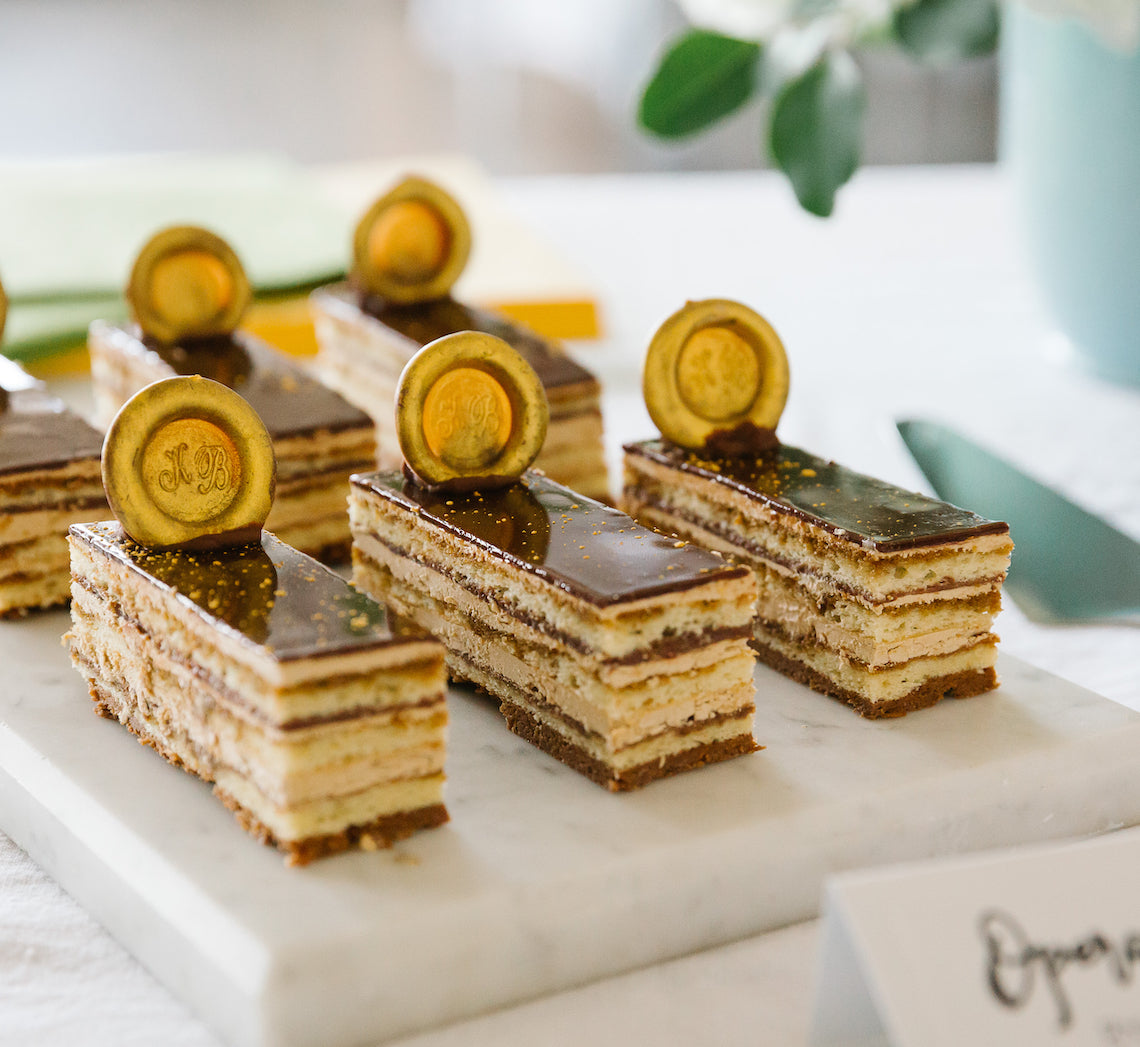
Prep 2hr (+ cooling time)Bake 8-10minMakes 18 serves
Created by Make Me a Baker student, Karthika Biju for her graduation, this stunning cake brings together numerous techniques learnt throughout the 6-month course. A real challenge, this dessert is an exquisite combination of chocolate and coffee-infused layers of almond sponge, ganache, chocolate croustillant, hazelnut praline and Swiss meringue buttercream. Karthika finished each portion of cake with gold dust and leaf and also personalised them with a chocolate disc monogramed with her initials. Not for the faint-hearted baker, this recipe is nothing short of a challenge but the results will definitely reflect the effort.
Ingredients
Edible gold leaf and dust, to decorateJoconde (Almond Sponge)
Melted butter, to grease5 eggs, at room temperature
140g almond meal
140g soft icing sugar mixture
30g plain flour
5 egg whites
30g caster sugar
¼ teaspoon salt
30g unsalted butter, melted
Coffee Syrup
160ml (2/3 cup) water100g caster sugar
3 teaspoons instant coffee powder
Hazelnut Praline Paste
125g whole raw hazelnuts75g caster white sugar
2 teaspoons water
¼ teaspoon salt
Chocolate Croustillant
40g good-quality dark chocolate (45% cocoa), chopped or callets30g Hazelnut Praline Paste
70g Paillette Feuilletine (see Baker’s Tips)
Chocolate Ganache
160g good-quality dark chocolate (45% cocoa), chopped or callets160ml (2/3 cup) thickened cream
Swiss Meringue Coffee Buttercream
4 egg whites, at room temperature200g caster sugar
1/2 teaspoon salt
250g unsalted butter, at room temperature
Coffee extract, to taste
Chocolate Glaze
6.6g gelatine leaves250ml (1 cup) chilled water
125ml (1/2 cup) room temperature water
225g caster sugar
150g good-quality dark chocolate (70% cocoa), callets or chopped
30g cocoa powder, sifted
65ml pure cream (35% butterfat)
Monogramed Chocolate Discs
70g good-quality dark chocolate (45% cocoa), callets or choppedEdible gold lustre paint (See Baker’s Tips)
Wax seal (kept in freezer for at least 45 minutes)
Joconde (Almond Sponge Cake)
- To make the Joconde, preheat the oven to 200°C (180°C fan-forced). Brush two 23cm x 33cm shallow baking trays with melted butter and line the base and sides of each with one piece of non-stick baking paper, cutting into the corners to fit.
- Sift the almond meal and icing sugar into a large bowl. Add the whole 5 eggs and use an electric hand mixer to mix until the mixture is creamy. Stir in the flour until just combined.
- Use an electric mixer with a whisk attachment on medium speed to whisk the egg whites and salt in a large clean bowl until soft peaks form. Gradually whisk in the sugar and continue to whisk until stiff peaks form. Use a spatula or large metal spoon to fold the egg whites through the almond mixture. Add the melted butter and fold gently together.
- Divide the batter evenly between the prepared tins. Bake in preheated oven for 8-10 minutes until lightly golden and cooked through. Cool in the tins.
- Carefully turn the cooled cakes onto a cutting board and cut each into one 20cm square and one 10cm x 20cm rectangle.
Coffee Syrup
- To make the Coffee Syrup, place the water, sugar and coffee into a small saucepan and stir over medium heat until the sugar dissolves. Bring to the boil then remove from heat and set aside to cool completely.
Caramel
- Place the sugar and water in a saucepan over low heat. Leave it to heat until the sugar has melted. Do not stir. Continue cooking until it has turned a golden caramel.
- Meanwhile, fill your sink with cold water. Once the caramel is ready, dip the base of the saucepan in the cold water for a few seconds to stop the cooking process. Set the pan on a towel on the bench.
Hazelnut Praline Paste
- To Make the Hazelnut Praline Paste, reduce the oven temperature to 180°C (160°C fan-forced) and roast the hazelnuts for 10-15 minutes, stirring them every 5 minutes, or until aromatic and the skins start to crackle.
- Wrap the warm hazelnuts in a tea towel and set aside to steam for 10 minutes. Use the tea towel to rub to hazelnuts against it and each other to remove the skins.
- Line an oven tray with non-stick baking paper or a silicone mat. Place the sugar and water in a small heavy-based saucepan and stir over medium heat until the sugar dissolves. Bring to a simmer and simmer over medium heat, brushing down the sides of the saucepan with a pastry brush dipped in water to remove any sugar crystals from the sides of the pan, until a deep golden toffee forms. Remove from the heat add the toasted skinned hazelnuts but don’t stir. Pour immediately onto the lined tray and set aside to cool completely.
- When the toffee is cool, break into small pieces. Add about a quarter of the toffee shards to a food processor bowl and process until ground. With the motor running, add the remining toffee shards and process until ground. Add the salt and continue to process until a smooth paste with a peanut butter consistency forms (see Baker’s Tips).
Chocolate Hazelnut Croustillant
- To make the Chocolate Croustillant, place the chocolate in a heatproof bowl and place over a saucepan of barely simmering water (don’t let the base of the bowl touch the water). Stir occasionally until melted and smooth.
- Add Pailleté Feuilletine and Hazelnut Praline Paste to the melted chocolate and stir to combine. Spread the croustillant over the 20cm square layer of sponge cake on the board. Place in the fridge to set
Chocolate Ganache
- To make the Chocolate Ganache, place the chocolate in a heatproof bowl. Heat cream in a small saucepan over medium heat and bring just to the boil.
- Pour the cream over the chocolate and set aside for 1 minute. Stir until smooth. Set aside to cool at room temperature, stirring occasionally, until it thickens to a peanut butter consistency (see Baker’s Tips).
Coffee Buttercream
- To make the Coffee Buttercream, combine the egg whites, sugar and salt in a medium heatproof bowl. Place the bowl over a pan of simmering water (don’t let the base of the bowl touch the water). Use a balloon whisk to stir until the sugar dissolves. Continue to stir until the mixture reaches 70°C on a thermometer.
- Transfer the mixture to the bowl of a stand mixer and whisk on high speed with the whisk attachment until the mixture is very thick and glossy and has cooled completely to room temperature.
- Replace the whisk with the paddle attachment and gradually add the room temperature butter a tablespoon at a time, beating well on medium-high speed after each addition, before adding the next lot. Once all the butter has been incorporated, beat in the coffee extract.
Cake Assembly
- Remove the croustillant-coated sponge cake layer from the fridge and carefully flip it onto a on a another cutting board with chocolate croustillant facing down. Brush the sponge with about a third of the coffee syrup and then spread with half of the coffee buttercream. Place the two 10cm x 20cm sponge layers side by side on top to cover and brush with half of the remaining coffee syrup.
- Reserve about 1/4 cup of the ganache and spread the sponge evenly with the remaining chocolate ganache. Top with the remaining layer of sponge cake and brush well with the remining coffee syrup. Spread with the remaining buttercream to cover and even the surface using an offset spatula or cake scraper. Cover and refrigerate the cake for at least 2 hours or overnight.
Monogramed Chocolate Discs
- Line a tray with non-stick baking paper. Remove the wax seal from the freezer and place in a bowl of ice.
- Melt the chocolate in the microwave for 10 seconds bursts on high, stirring well after each burst until the chocolate is completely melted. Spoon the chocolate into a zip-lock bag and cut a small hole in one corner. Working quickly, pipe the chocolate onto the lined try to form three discs, each about the size of a dollar coin. Immediately use the chilled wax seal to imprint the chocolate discs, holding on each for 5 seconds. Place the seal back in the ice (see Baker’s Tips) and repeat with the remaining chocolate making and imprinting three discs at a time. Set aside at room temperature to set and firm.
- Once set use a small paintbrush to paint each disc with edible lustre gold paint to coat.
Chocolate Glaze
- When ready to glaze the cake, carefully transfer the cake to a rack over a tray lined with baking paper. Return to the fridge.
- To make the Chocolate Glaze. Place the gelatine sheets in a bowl and add 250ml (1 cup) of the chilled water to cover. Set aside.
- Place the chocolate in a medium heatproof bowl. Combine the remaining 125ml (1/2 cup) water in a small saucepan with the sugar. Stir over medium heat until the sugar dissolves. Bring to the boil and boil gently, brushing down the sides of the pan with a pastry brush dipped in water to dissolve any sugar crystals, until the syrup reaches 104°C on a thermometer.
- Remove the syrup from the heat and pour over the chocolate. Stir until the chocolate melts and the mixture is smooth. Sift the cocoa powder over the chocolate mixture and use a balloon whisk to stir until combined and smooth. Add the cream and stir until the mixture cools to 60°C on a thermometer.
- Use your hands to squeeze as much water as possible from the gelatine sheets and add to the warm chocolate mixture. Stir until dissolved.
- Transfer the mixture to a jug anduse a stick blender to blend until the mixture is emulsified and smooth. Strain the glaze through a fine mesh sieve.
- Once the glaze cools to 32°C on a thermometer pour it immediately over the chilled cake to create a smooth surface, allowing any excess to drip down the sides. Refrigerate for about 1 hour or until the glaze is set.
To Serve
- Use a hot, dry knife trim the edges of the cake and then cut into 18 pieces (each about 7cm x 3cm). Transfer to a serving plate. Soften the reserved Chocolate Ganache by heating in 10 second bursts on high and stirring between each burst until smooth. Cool until almost a piping consistency. Spoon into a piping bag fitted with a small star nozzle. Pipe a rosette of ganache at the end of each cake portion and rest a Monogramed Chocolate Disc against the rosette to hold it. Decorate with gold leave and dust as desired.
Baker's Tips
- Paillette Feuilletine is fine broken shards of Crêpes Dentelle (a crisp biscuit made from rolled crêpes)and is used to add texture to confections and desserts. It is available from specialty food stores and French delicatessens.
- Edible lustre gold paint is available from specialty cake decorating shops and suppliers and some craft stores.
- The Hazelnut Praline Paste will be coarse crumbs in the beginning, but it will eventually get smooth with processing. Don’t add water to thin the mixture but a little vegetable oil can be added to reach the right consistency is needed.
- The longer the Chocolate ganache stands at room temperature the thicker it will become. It is ready to use when it becomes a peanut butter-like consistency. If left for too long, it will become too thick to spread.
- The wax seal must be left in the ice between imprinting the discs for it to work effectively and not stick to the chocolate.
Karthika based this recipe on one from https://www.homecookingadventure.com.
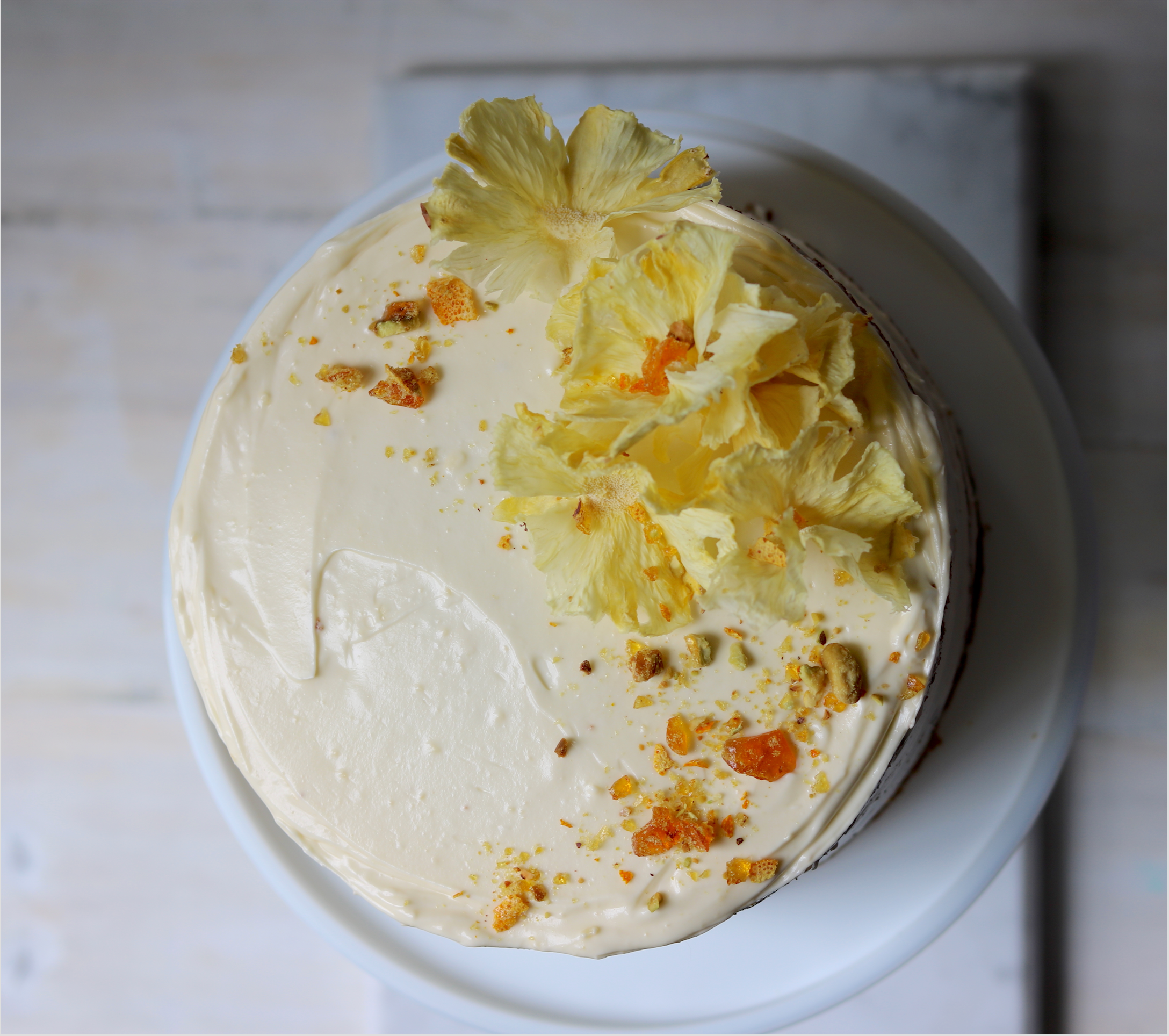
Prep 1hr30min (+ cooling time)Bake 3hr20minMakes 10-12 serves
I often create unique cakes for friends to celebrate special occasion and milestones – cakes that reflect their personalities and our friendship. This one was for my close friend, Tina, to celebrate her 50th. It is based on a recipe by well-respected Australian cooking teacher Greta Anna Teplitzky (from her cookbook The Greta Anna Recipes, published by Angus & Robertson in the 1970s). Tina’s mum made it often while she was growing up and it became childhood favourite. I have zhooshed the original up with a dried orange and pistachio praline and some fun dried pineapple flowers to match Tina’s gorgeous, vibrant and creative personality – quite appropriate I think!
Ingredients
Orange and pistachio praline
1 orange
45g (⅓ cup/1½oz) pistachios, lightly toasted
55g (¼ cup/2oz) caster sugar
1½ tablespoons water
Dried pineapple flowers
½ firm, ripe pineapple
Cake layers
300g (2 cups/10½oz) plain flour
2 teaspoons baking powder
1 teaspoon bicarbonate of soda
2 teaspoons mixed spice
300g (10½oz) brown sugar
200ml (7fl oz) light olive oil, plus extra to grease
4 eggs, at room temperature, lightly whisked
2 teaspoons natural vanilla essence or extract
450g (15¾oz) tin pineapple slices in syrup, drained and finely chopped
300g (2 cups, firmly packed/10½oz) coarsely grated carrot
Cream Cheese Frosting
250g (9oz) cream cheese, at room temperature
75g (2¾oz) salted butter, at room temperature
1 teaspoon natural vanilla essence or extract
185g (1½ cups / 6½oz) icing sugar mixture, sifted
Method
- To make the Orange & Pistachio Praline, preheat the oven to 100°C/212°F (80°C/175°F fan-forced). Remove the rind from the orange with a vegetable peeler and then use a small sharp knife to remove any white pith from the rind. Place the rind on a wire rack over an oven tray and place in the preheated oven for 2 hours or until dry and crisp but still bright orange in colour (see Baker’s Tips). Remove from the oven and set aside (leave the oven on). Line an oven tray with non-stick baking paper. Spread the pistachios and dried orange rind close together on the lined tray. Combine the caster sugar and water in a small saucepan and use a wooden spoon to stir over low heat until the sugar dissolves. Increase the heat to medium and bring to the boil. Boil for 8-10 minutes without stirring, brushing down the side of the pan with a pastry brush dipped in water to dissolve any sugar crystals, until the mixture turns a deep caramel. Pour immediately onto the lined tray over the pistachios and rind. Set aside to cool completely (this will take about 30 minutes). When cool, use a mortar and pestle to grind the toffee into a coarse praline. Transfer to an airtight container and set aside (see Baker’s Tips).
- To make the Dried Pineapple Fowers, stand the half pineapple upright on a cutting board and use a large sharp knife to cut off the skin in strips. Use a mandoline slicer to cut the pineapple into very thin rounds (about 1-2mm thick). Use a small sharp knife to remove any remaining dark bits of rind from the slices and then pat both sides with paper towel to remove any excess moisture. Place the slices on a wire rack on an oven tray (see Baker’s Tips). Place in the oven for 2½ hours or until crisp around the edges but still slightly pliable. Remove from the oven and pinch each slice in the center while still warm to form a flower. Set aside to cool and then store immediately in an airtight container until needed (see Baker’s Tips)
- To make the Cake Layers, preheat oven to 180°C/350°F (160°C/315°F fan-forced). Brush two 18cm/7in round cake tins with extra olive oil to lightly grease and line the bases with non-stick baking paper.
- Sift together 150g (1 cup/5 ¼oz) plain flour, 1 teaspoon baking powder, ½ teaspoon bicarbonate of soda and 1 teaspoon mixed spice into a large bowl. Add 150g (5 ¼oz) brown sugar and stir to combine, breaking up any lumps.
- Combine 100ml (3 ½fl oz) of the olive oil, 2 of the eggs, 1 teaspoon vanilla, half the chopped pineapple and 150g (5 ¼oz) of the grated carrot and mix well. Add to the flour mixture and use a spatula or large metal spoon to gently mix until just combined.
- Divide the mixture evenly between the prepared tins and spread with the back of a metal spoon to smooth the surface making a shallow well in the center of each cake. Bake in preheated oven for 25 minutes or until cooked when tested with a skewer.
- Stand the cakes in the tins for 5 minutes before turning onto wire racks to cool (this will take about 1 hour). Repeat with the remaining cake ingredients to make 2 more cake layers.
- To make the Cream Cheese Frosting, use an electric mixer to beat the cream cheese, butter and vanilla until very smooth. Gradually add the icing sugar, beating well after each addition and beat until well combined and very creamy.
- To assemble the cake, first trim the tops of the cake layers if necessary (if the well you made in the mixture before baking was deep enough you won’t have to do this). Place one cooled cake layer, top side up on a cake stand or serving plate. Spread with ½ cup of the Cream Cheese Frosting and then sprinkle with about 1½ tablespoons of the Orange & Pistachio Praline. Continue to layer with the remaining cake layers, spreading each with ½ cup of frosting and sprinkling with about 1½ tablespoons of praline, and finishing with a cake layer, top side down. Spread a thick layer of frosting over the top of the cake, evening the surface with a large palette knife. Spread any remaining icing around the side of the cake to create a ‘naked’ look. Decorate with the Dried Pineapple Flowers and sprinkle with a little of the remaining praline just before serving.
Baker's Tips
- You can dry the orange rind for the praline (in step 1) and the pineapple for the flowers (in step 2) at the same time if you like.
- The praline will keep in an airtight container for up to 2 weeks.
- You will only need 5-6 slices of pineapple to make the dried pineapple flowers for this cake but if you would like to make more, place the slices on an extra wire rack on top of the first one and separate the racks with balls of foil at the corners between them.
- The Dried Pineapple Flowers will keep in an airtight container in a cool spot for up to 4 days. If they soften and lose their shape, return to an oven preheated to 100°C/212°F (80°C/175°F fan-forced) for 20-30 minutes or until crisp around the edges again. Reshape as in step 2.
- This cake will keep in an airtight container in the fridge for up to 3 days. Stand at room temperature for at least 30 minutes before serving.
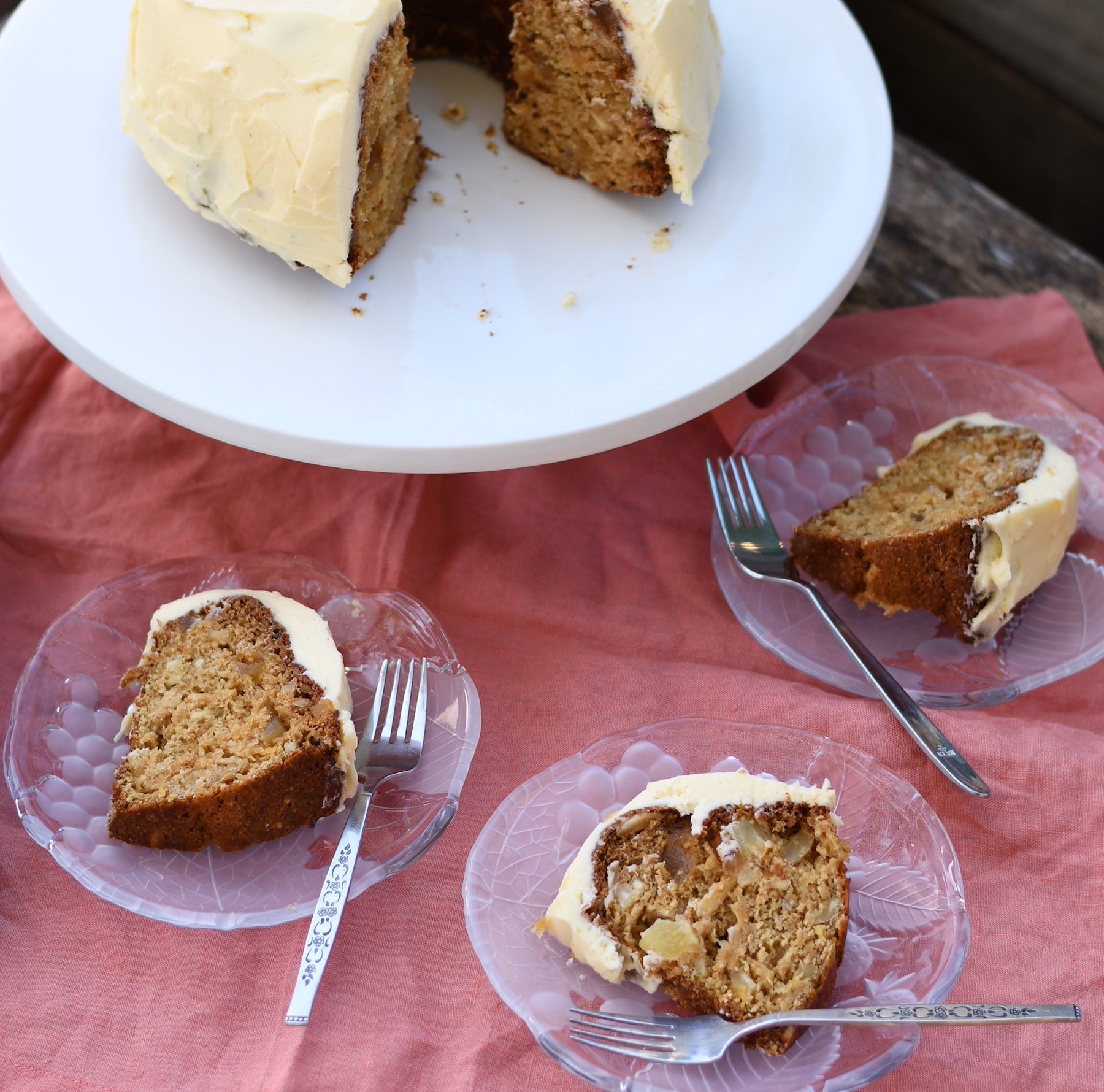
Prep 15 mins (+1 hour cooling)Bake 40minMakes 10 serves
This cake was shared by Hannah Scott as part of her Make Me a Baker program homework for Module 5.
"This sturdy but moist cake is a real crowd pleaser and a favourite in my family. To be honest, I’m not exactly sure why it’s called a Mexican Wedding Cake as I don’t think it’s traditionally served at weddings, but since my family usually make it for family gatherings and celebrations, the name has stuck. It’s super easy to make using the measure and beat method."
Ingredients
- 15g melted butter mixed with 1 teaspoon plain flour
- 310g plain wholemeal flour (unsifted)
- 2 teaspoons bicarbonate of soda
- 165g brown sugar
- 2 eggs, at room temperature, lightly whisked
- 85g slivered almonds
- 100g coarsely chopped glace ginger
- 450g tin crushed pineapple in natural juice, (with its juice)
Icing
- 75g butter, at room temperature
- 250g cream cheese, at room temperature
- 125g icing sugar, sifted
- 2 teaspoons natural vanilla extract or essence
Method
- Preheat oven to 180°C (160°C fan-forced). Brush a 2 litre (8 cup) fluted ring or bundt tin with the melted butter and flour mixture to grease.
- Place the flour, bicarbonate of soda, brown sugar, eggs, almonds, glace ginger and crushed pineapple into a mixing bowl and use an electric mixer to beat on low speed until well combined.
- Pour the cake batter into the prepared tin. Bake in preheated oven for 40 minutes or until a skewer inserted into the cake comes out clean.
- Stand the cake in the tin for 5 minutes before turning onto a wire rack to cool (this will take about an hour).
- Meanwhile, to make the Icing, use an electric mixer to beat the butter, cream cheese, icing sugar and vanilla until pale and creamy.
- Once cake has cooled completely, use the back of a metal spoon to gently spread the icing all over the cake. Serve in slices.
Baker's Tips
- This cake will keep in an airtight container in the fridge for up to 3 days. Serve at room temperature.
Hannah Scott (aka @thefoodstoryteller) won a scholarship to BakeClub's Make Me a Baker program thanks to SBS Food. Her rustic approach to baking is partly to thank for winning her the top spot in the competition. Stay tuned to Instagram and the blog to follow her Make Me a Baker journey over the next 6 months! In the meantime, click here to get to know a little more about her.
To find out more about how you can be part of a future Make Me a Baker program, click here.
Photography by Hannah Scott.
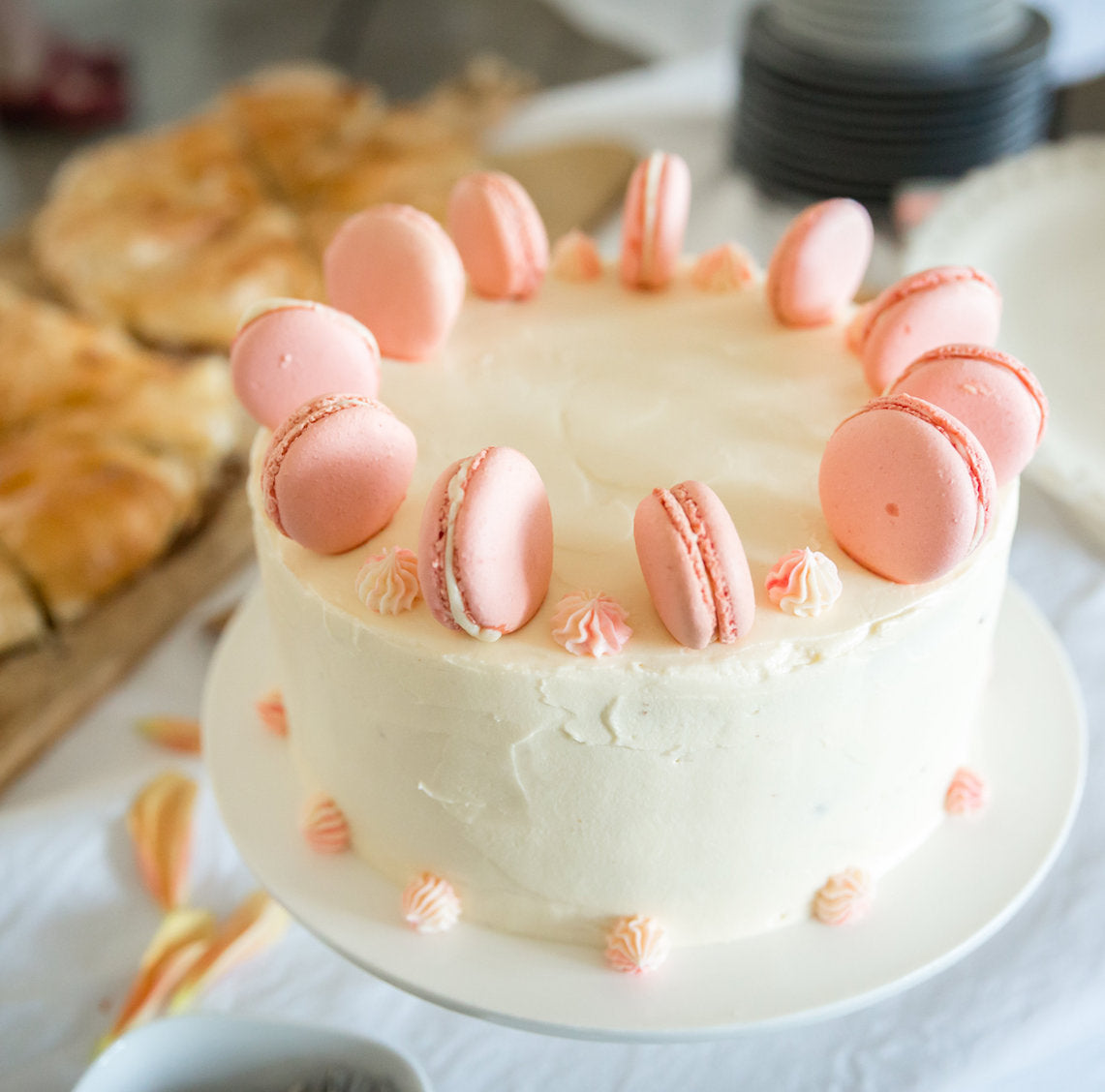
Prep 2hrBake 40-45minMakes 12-15 serves
This impressive cake was created by Débora Bueno Leite, one of our Make Me a Baker students, for her graduation. It marries two gems from the state of Minas Gerais in her native Brazil, guava paste and cheese – when served together they are known as ‘Romeo & Juliet'.
Ingredients
- 250ml (1 cup) milk combined with 2 tablespoons sweetened condensed milk
- 11 guava macarons, to decorate
Cake layers
- Melted butter, to grease
- 375g (2½ cups) plain flour
- 2½ teaspoons baking powder
- ½ teaspoon table salt
- 250g butter, at room temperature
- 440g (2 cups) caster sugar
- 1 teaspoon natural vanilla extract or essence
- 4 eggs, at room temperature
- 250ml (1 cup) full-cream milk
Guava Filling
- 200g good-quality guava paste (available from good delicatessens and specialty food stores)
- 125ml (½ cup) water
Cream Cheese Filling
- 300g cream cheese, at room temperature
- 200ml cold thickened cream
- 160ml (2/3 cup) sweetened condensed milk
Cream Cheese Frosting
- 680g cream cheese, at room temperature
- 115g unsalted butter, at room temperature
- 240g icing sugar, sifted
- 2 teaspoons natural vanilla extract or essence
- Queen red food colour gel, to tint
Method
- Preheat oven to 180°C (160°C fan-forced). Grease two deep 20cm round cake tins with melted butter and line the bases with non-stick baking paper.
- Sift together the flour, baking powder and salt into a medium bowl. Set aside.
- Use an electric stand mixer fitted with a paddle attachment to beat the butter, sugar, and vanilla for about 8 minutes, scraping down the side of the bowl when necessary, or until pale and creamy.
- Add the eggs, one at a time, beating well after each addition and scraping down the side of the bowl when necessary, until well combined.
- Add the flour mixture in four equal portions, alternating with the milk in three portions, mixing on lowest possible speed until just incorporated before adding the next; do not overmix.
- Divide the batter into the prepared tins and use the back of a metal spoon to smooth the surface. Bake in preheated oven, swapping the tins around halfway through baking, for 40-45 minutes or until a skewer inserted into the centre of the cakes comes out clean.
- Transfer the cake tins to a wire rack and allow the cakes to cool completely in the tins. Once cool, cover each tin tightly with plastic wrap and refrigerate overnight.
- To make the Guava Filling, combine with guava paste and water in a small saucepan and stir over medium heat until the paste is creamy. Set aside to cool completely.
- To make the Cream Cheese Filling, use an electric mixer with a paddle attachment to beat the cream cheese for about 3 minutes or until soft and creamy; set aside. Whisk the cream with a balloon whisk or electric mixer with a whisk attachment in a clean bowl until soft peaks form. Add the cream cheese with the condensed milk and whisk until just combined and smooth. Set aside.
- To make the Cream Cheese Frosting, use an electric mixer fitted with a paddle attachment to beat the cream cheese for about 3 minutes or until smooth and creamy; transfer to another bowl and set aside. Beat the butter about 3 minutes or until pale and creamy. Add the cream cheese, icing sugar and vanilla and beat until well combined and frosting is creamy.
- Remove the cakes form the tins. Cut each cake layer in half horizontally and then brush with the milk and sweetened condensed milk mixture to moisten. Place one layer on a serving plate or cake stand and spread with some of the Cream Cheese Filling and then one third of the Guava Filling. Continue layering with the remaining cake layers, Cream Cheese Filling and Guava Filling, finishing with a cake layer, top side down.
- Spread the side and top with Cream Cheese Frosting to cover, using a spatula or cake scraper to smooth evenly.
- Add a little red gel colour to the remaining Cream Cheese Frosting and swirl so that it is marbled. Place in a piping bag fitted with a small star nozzle (Débora used a Wilton #18 star) and pipe small rosettes around the side and top of the cake (as shown in the image). Place the macarons between the rosette on the top to decorate.
Baker's Tips
- This cake will keep in an airtight container in the fridge for up to 3 days. Serve at room temperature.
This recipe was created by Débora for her Make Me a Baker graduation using inspiration from a number of different recipes including those from www.howtocakeit.com, Gretchen’s Bakery YouTube channel, Karen Munhoz YouTube channel and a class she took with MakMak Macarons.
Photography by Amy Piddington.
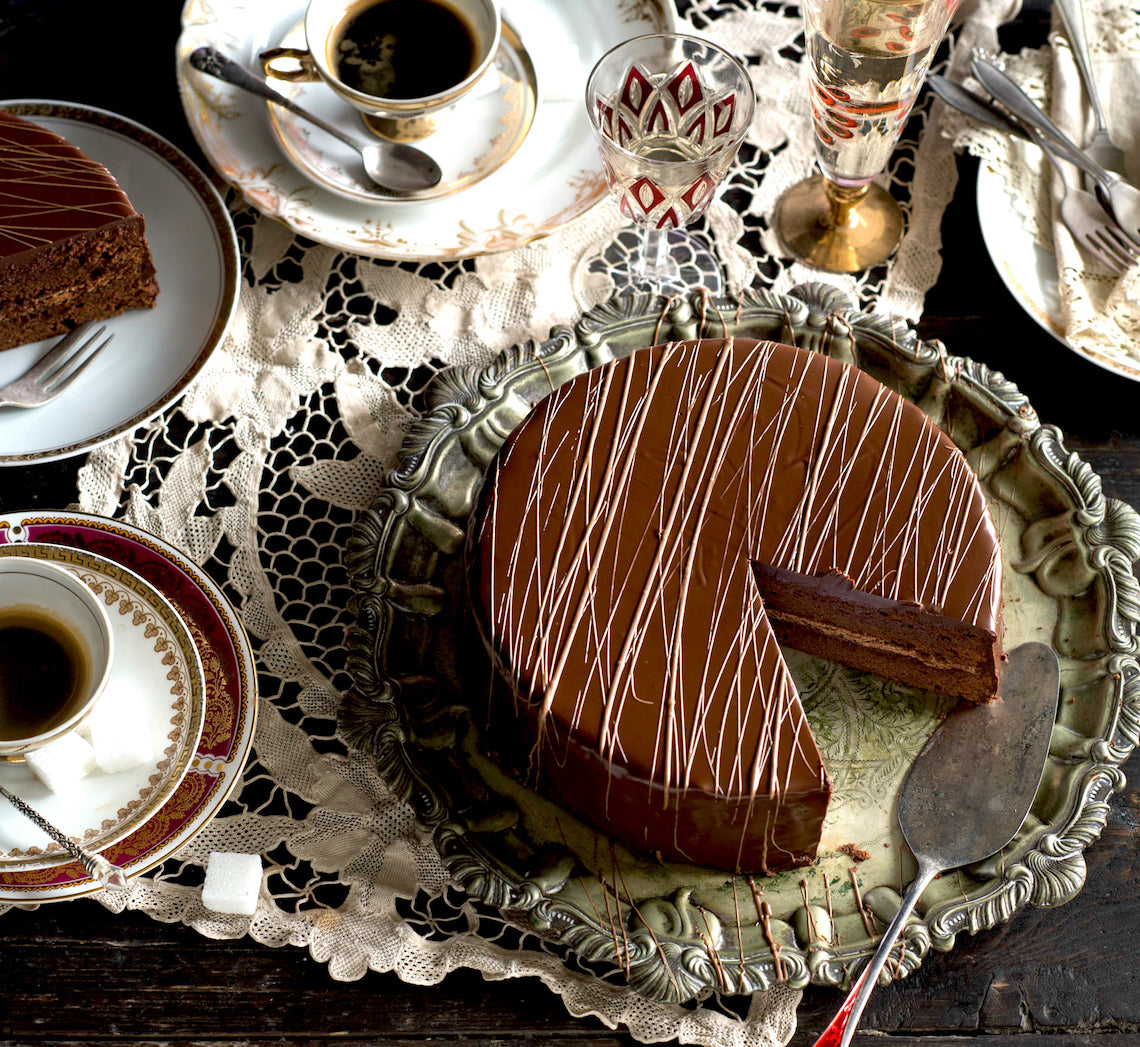
Prep 40min (+1hr cooling and 2hr standing time)Bake 30minMakes 10-12 serves
Possibly the most famous cake in the world, and certainly the pride of Austria, Sacher Torte was created by Franz Sacher, a 16-year-old apprentice stepping in for an ill head chef, to impress the guests of Prince Wenzel von Metternich. And as they say, the rest is now cuisine history. This elegant, rich and enticing cake is now loved the world over.
Ingredients
Melted butter, to grease
125g unsalted butter, softened
125g (1 cup) icing sugar, sifted
1½ teaspoons natural vanilla essence or extract
6 eggs, at room temperature, separated
175g good-quality dark chocolate (54% cocoa), chopped, melted and cooled to room temperature
110g (¾ cup) plain flour
110g (½ cup) caster sugar
85g (¼ cup) apricot jam, warmed and sieved
40g good-quality milk chocolate, melted, to decorate
Thick or whipped cream, to serve
Chocolate Glaze
300g good-quality dark chocolate (54% cocoa)
60g butter, cubed
Method
- Preheat oven to 180°C (160°C fan-forced). Brush 2 x shallow 20cm round cake tins with melted butter to grease and line the bases with rounds of non-stick baking paper.
- Use an electric mixer to beat the butter, icing sugar and vanilla until pale and creamy. Add the egg yolks and beat until well combined and creamy. Beat in the cooled melted chocolate until well combined. Use a large metal spoon or spatula to fold in the flour until just combined.
- Use an electric mixer with a whisk attachment to whisk the egg whites in a large clean, dry bowl until soft peaks form. Add the caster sugar and whisk on medium-high speed until thick and glossy and all the sugar has dissolved (see Baker’s tip). Add half the egg white mixture to the chocolate mixture and use a large metal spoon or spatula to fold in to ‘loosen’ the mixture. Add the remaining egg white mixture and fold until just evenly combined.
- Divide the mixture evenly between the tins and use the back of a spoon to smooth the surface. Bake in preheated oven for 30 minutes or until a skewer inserted into the centre of the cakes comes out clean. Stand in the tins for 10 minutes before turning onto a wire rack to cool (this will take about 1 hour).
- Once cool, spread one cake layer with the warmed sieved jam and then top with the second layer, bottom side up. Place the cake on a wire rack over a tray and set aside while making the chocolate glaze.
- To make the chocolate glaze, combine the chocolate and butter in a heatproof bowl and place over a saucepan of barely simmering water (make sure the base of the bowl doesn’t touch the water). Stir occasionally until just melted and combined. Use a plate knife to spread a little of the glaze over the outside of the cake to form a ‘crumb coat’ and to even the surface. Place in the fridge for 20 minutes or until set. Remove from the fridge and carefully pour over the rest of the glaze, allowing it to run down the sides of the cake to coat evenly. Tap the cake, still on the rack, gently on the tray to remove any air bubbles and to settle the glaze. Use a fork to drizzle the milk chocolate over the top of the cake to decorate. Set aside for 2 hours or until the glaze sets. Serve cut into small wedges with cream.
Baker’s Tips
- To test if all the sugar has dissolved, rub a little of the egg white and sugar between two fingers – you will be able to feel if there is still undissolved sugar. Whisk for another minute if not completely dissolved before testing again.
- This cake will keep in an airtight container at room temperature for up to 4 days.
This recipe is from Anneka's SBS Food online column, Bakeproof: Austrian Baking.
CLICK HERE for more Bakeproof columns and recipes.
Photography by Alan Benson.
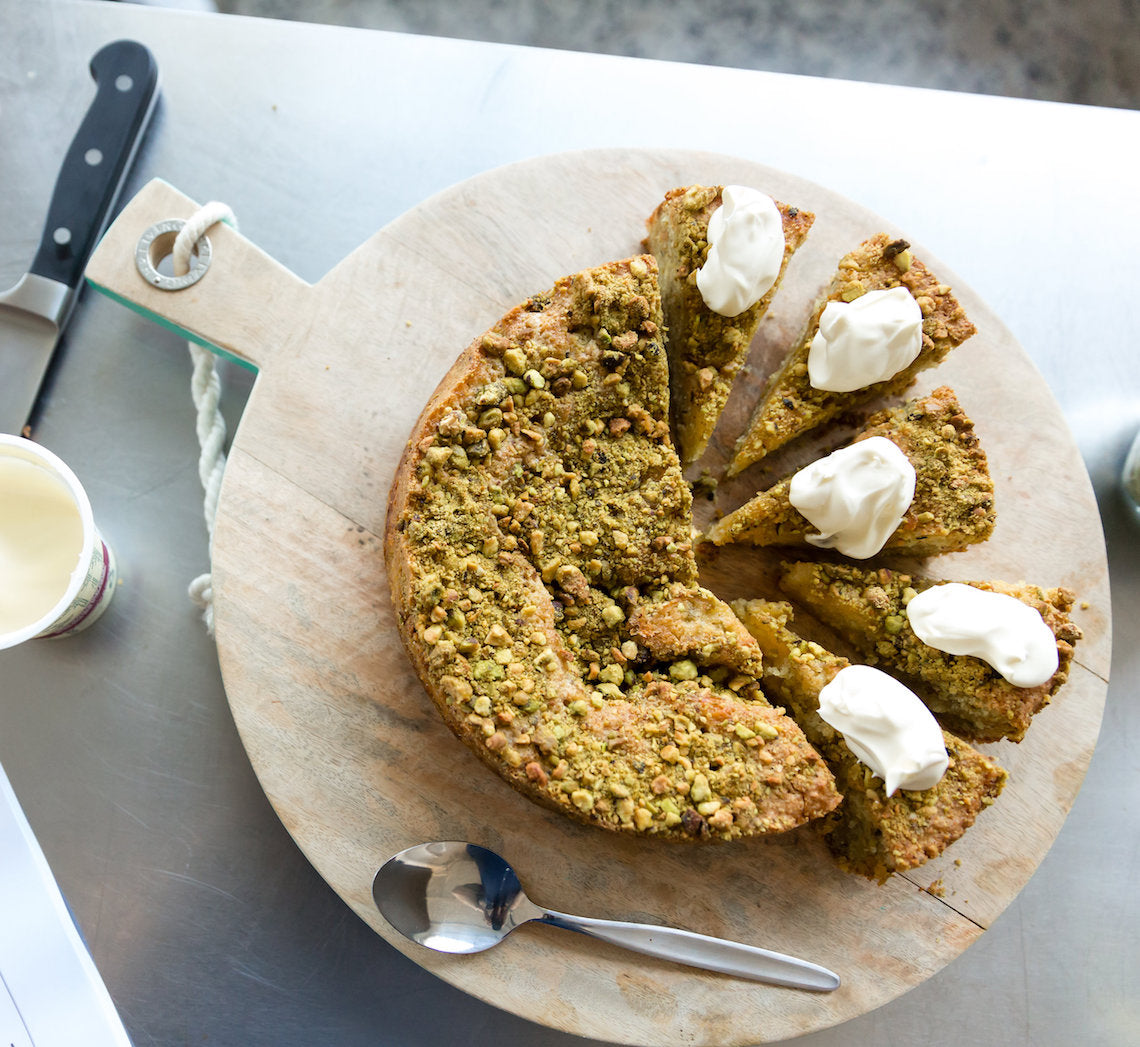
Prep 25min (+ lemon curd making time)Bake 50minMakes 10-12 serves
This wonderful cake was created by one of our Make Me a Baker graduates, Lisa Frost, for her graduation ceremony. Mor-ish with a lovely 'wholesomeness', the secret to this wonderful cake is that a layer of Lisa's vegan lemon curd is baked into the cake giving it a fabulously tangy, moist centre.
Ingredients
1 quantity Vegan Lemon Curd, chilled
Double / thick cream, to serve
2 tablespoons coarsely chopped pistachios, to serve
Cake
Cooking oil spray, to grease
160g (1¼ cups) finely chopped pistachios kernels
125g unsalted butter, at room temperature
150g (¾ cup) organic coconut sugar
1½ tablespoons finely grated lemon rind
50g (¼ cup) apple puree
3 eggs, at room temperature
100g (⅔ cup) plain cake flour
1 teaspoon baking powder
Method
- Preheat oven to 180°C (160°C fan-forced). Grease a 22cm round springform tin then line base and sides with 2 layers of baking paper. Spray the side lining paper with oil, avoiding the base of the pan. Place ¼ cup of the pistachios in the pan and rotate pan on its side to coat the side with nuts.
- Use an electric mixer to beat the butter, sugar and lemon rind until pale and creamy, scraping down the side of the bowl when necessary. Mix in the apple puree on low speed. Add the eggs one at a time, beating well after each addition until well combined.
- Sift together the flour and baking powder. Add ⅔ cup of the remaining pistachios and stir to combine. Use a large metal spoon or spatula to fold the dry ingredients into the egg mixture until just combined.
- Spoon the cake mixture into tin, spreading evenly. Drop the tin on the bench to settle the mixture. Spread 1 cup of the chilled curd over batter, spreading evenly. Sprinkle with the remaining pistachios. Cover the surface of the remaining curd with plastic wrap and return to the fridge.
- Bake for 40 minutes. Cover the surface of the cake lightly with a round of baking paper to prevent the nuts from burning and return to the oven for another 10 minutes or until a skewer inserted into the centre comes out clean (the top of the cake will still be slightly wobbly).
- Allow the cake to stand in the pan for at least 10 minutes before removing the side. Serve warm or at room temperature with the cream, remaining lemon curd and pistachios.

Prep 30min (+1hr cooling and 30min standing time) Bake 40minMakes 10 serves
This dairy-free, flourless number is the Jewish Passover dessert of choice.
Ingredients
75g (⅔ cup) cocoa powder, sifted
165ml (⅔ cup) boiling water
200g pecans, toasted
1 teaspoon gluten-free baking powder
4 eggs, at room temperature
220g (1 cup) raw caster sugar
200ml light olive oil, plus extra to grease
1½ teaspoons natural vanilla essence or extract
Dairy-free ganache
185g dairy-free dark chocolate, chopped
60g dairy-free spread
Method
- Preheat oven to 170°C (150°C fan-forced). Grease a 22cm springform tin with extra oil and line the base with non-stick baking paper.
- Place the cocoa in a medium bowl and gradually stir in the boiling water until smooth. Set aside to cool.
- Process the pecans in a food processor until finely ground. Transfer to a medium bowl and stir through the baking powder until evenly combined.
- Use an electric mixer with a whisk attachment to whisk the eggs, sugar, oil and vanilla on high speed for about 5 minutes or until thick and pale. Add the cocoa mixture and whisk until just combined. Add the pecan mixture and stir until just combined.
- Pour the mixture into the prepared tin and bake in preheated oven for 40 minutes or until wet crumbs cling to a skewer inserted into the centre. Cool the cake in the tin sitting on a wire rack.
- To make the dairy-free ganache, combine the chocolate and dairy-free spread in a medium heatproof bowl over a saucepan of barley simmering water (make sure the waster doesn’t touch the bottom of the bowl). Stir occasionally until the chocolate melts and the mixture is smooth. Remove the bowl form the saucepan and set aside for 10 minutes, stirring occasionally, until the ganache thickens to a thick spreadable consistency.
- Remove the cake from the tin and place on serving plate. Spoon the ganache over the cake and use the back of a spoon to spread. Set the cake aside for 30 minutes or until the ganache sets. Serve in wedges.
Baker's Tips
- This cake will keep in an airtight container at room temperature for up to 1 week.
This recipe is part of Anneka's SBS Food Bakeproof: Jewish Baking online column. For more Bakeproof columns and recipes, click here.
Photography by Alan Benson.
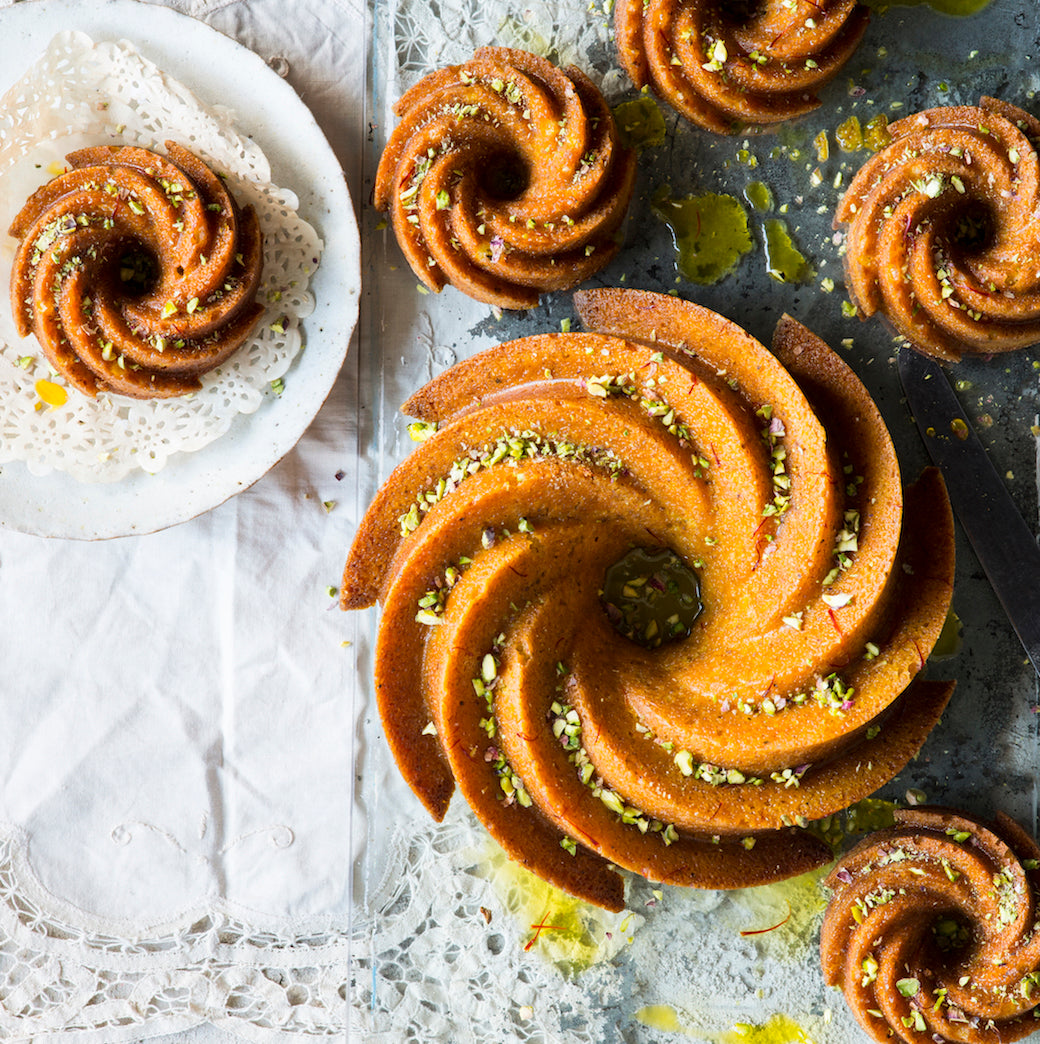
Prep 25min (+ 1hr cooling time)Bake 45minMakes 12 serves
This cake falls into that category of "less is more". The cake itself is a simple one-bowl mix whipped up in the food processor, but when baked in a decorative Bundt cake tin and infused with a flavoursome, and almost fluorescent, saffron syrup, it is one that will definitely impress.
Ingredients
15g (½oz) butter, melted
1 teaspoon plain flour
2 tablespoons unsalted pistachio kernels, toasted and chopped, to sprinkle
Orange and pistachio cake
100g (3½oz) unsalted pistachio kernels, toasted
1 orange (about 240g/8½oz), quartered, cored and seeds removed
220g (1 cup/7oz) caster sugar
125g (4½oz) salted butter, melted and cooled
2 eggs, at room temperature
185g (1¼ cups/6½oz) self-raising flour
Saffron syrup
1 large pinch saffron threads
125ml (½ cup/4fl oz) boiling water
125ml (½ cup/4fl oz) strained freshly squeezed orange juice
110g (½ cup/4oz) caster sugar
Method
- Preheat the oven to 170°C/340°F (150°C/300°F fan-forced). Combine the 15g/½oz melted butter with the 1 teaspoon plain flour and use a pastry brush to grease a 2 litre (8 cup/3.5pt) Bundt tin (see Baker's Tips).
- Place the pistachios in a food processor and process until very finely ground. Add the whole orange, sugar, butter and eggs to the food processor and process until the orange rind is finely chopped and the mixture is almost smooth. Add the self-raising flour and process briefly until just combined.
- Pour the mixture into the prepared tin. Tap the tin firmly on the benchtop 3 times to settle the mixture. Bake in preheated oven for 40-45 minutes or until a skewer inserted into the cake comes out clean. Stand the cake in the tin for 10 minutes.
- Meanwhile, place the saffron in a small dish and add about 1 tablespoon of the boiling water. Set aside to infuse. Combine the remaining boiling water, orange juice and sugar in a small saucepan and stir over low heat until the sugar dissolves. Add the saffron mixture, bring to a simmer over high heat. Reduce the heat to low and simmer for 5 minutes or until reduced slightly.
- Turn the cake onto a serving plate or cake stand with a lip. Gradually pour the hot saffron syrup over the hot cake, allowing it to soak in. Set aside and allow to cool (this will take about 1 hour). Serve sprinkled with the chopped pistachios.
Baker's Tips
- This cake will keep in an airtight container at room temperature for up to 3 days.
- I baked this cake in a Nordic Ware Heritage Bundt pan.
- You can also bake this cake as eight individual Bundts. Combine 30g (1oz) butter, melted, with 2 teaspoons plain flour and grease eight individual 250ml (1 cup/9fl oz) Bundt tins. Divide the mixture evenly among the tins and then tap them firmly on the benchtop 3 times to settle the mixture. Bake at 190°C/375°F (170°C/340°F) for 18-20 minutes or until a skewer inserted comes out clean. Stand in the tins for 5 minutes before turning onto a serving plate and pouring the syrup over. I used the Nordic Ware Heritage Bundtlette pans for these smaller Bundt cakes – each tray has 6 holes so you will have to bake the remaining two cakes separately.
This recipe is part of Anneka's SBS Food Bakeproof: Bundt Cakes online column. For more Bakeproof columns and recipes, click here.
Photography by Alan Benson.
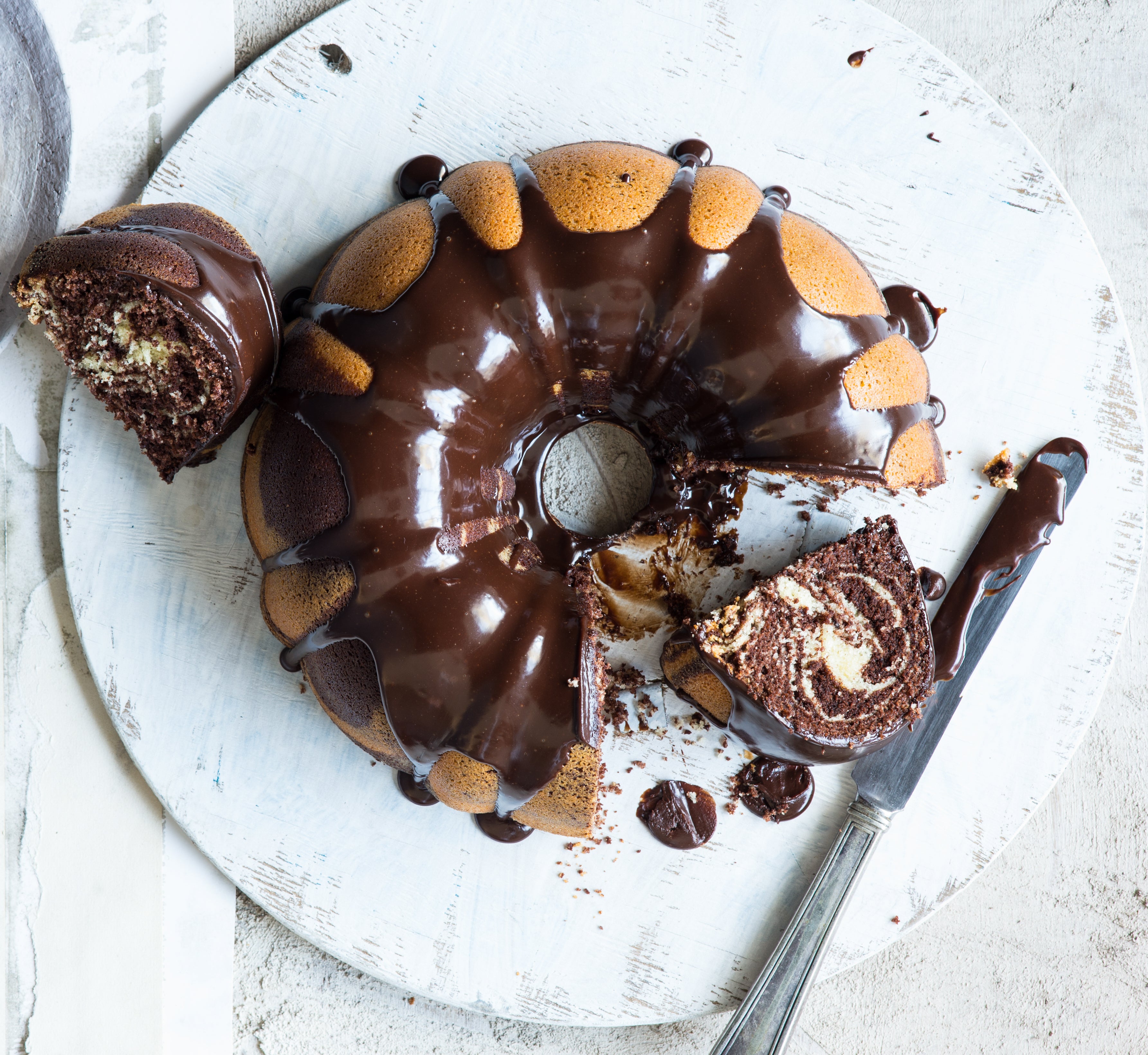
Prep 25min (+ 1hr cooling and 1hr standing time)Bake 55minMakes 12-14 serves
This is such a fun cake – the weight of alternating spoonfuls of mixture dropped on top of one another cause it to spread in the tin and create a wonderful ‘zebra’ stripped pattern that will be revealed when cut. It’s useful to remember that the smaller your spoonfuls of mixture are, the more delicate and intricate your design will be.
Ingredients
15g butter, melted
1 teaspoon plain flour
300g (2 cups) self-raising flour
70g plain flour
330g (1½ cups) caster sugar
250g salted butter, softened
4 eggs, at room temperature
185ml (¾ cup) water
2 teaspoons natural vanilla essence or extract
Cocoa mixture
55g (½ cup) cocoa powder, sifted
90ml boiling water
110g (½ cup) caster sugar
Chocolate fudge glaze
125g good-quality dark chocolate, chopped
110ml pouring (thin) cream
Method
- Preheat the oven to 170°C (150°C fan-forced). Combine the 15g melted butter with the 1 teaspoon plain flour and use a pastry brush to grease a 2 litre (8 cup) Bundt or fluted ring tin (see Baker's Tips).
- To make the cocoa mixture, place the cocoa in a medium bowl and gradually stir in the boiling water. Stir in the caster sugar and set aside.
- Put the flour, sugar, butter, eggs, water and vanilla in a large mixing bowl and use an electric mixer to beat on low speed until combined. Increase the speed to high and beat for 3-4 minutes or until paler in colour and silky smooth in texture. Transfer 2 cups (about 500g) of the cake mixture to a separate bowl. Add the cocoa mixture and use a spatula to mix until evenly combined.
- Drop a large spoonful of the vanilla mixture into the prepared cake tin. Drop a large spoonful of the cocoa mixture into the centre of the vanilla mixture. Continue dropping alternating spoonfuls of the mixtures into the tin directly on top of each other until all the mixture is used. The mixture will spread and even out as you add more, creating the ‘zebra’ pattern.
- Tap the tin firmly on the benchtop 3 times. Bake in preheated oven for 50-55 minutes or until a skewer inserted into the cake comes out clean. Stand the cake in the tin for 10 minutes before turning onto a wire rack to cool completely (this will take about 1 hour).
- To make the chocolate fudge glaze, place the chocolate in a heatproof bowl. Heat the cream in a small saucepan until almost simmering. Pour the hot cream over the chocolate and then set aside for 2 minutes. Stir until the chocolate melts and the mixture is smooth. Set aside at room temperature for 30 minutes, stirring occasionally, until thickened to a thick pouring consistency.
- Place the cake on the wire rack over a tray and pour the chocolate fudge glaze over. Set aside for 30 minutes or until the glaze sets.
Baker's Tips
- I used Baker’s Secret Fluted Tube Pan for this recipe but if you don't have this particular one, or a similar tin, you can use a greased and base-lined 24cm round cake tin instead.
- This cake will keep in an airtight container at room temperature for up to 2 days.
- The uniced cake also freezes well for up to 3 months. For the whole cake (or a portion of it), seal in an airtight container appropriate for its size before freezing. For individual pieces, wrap in plastic wrap and seal in an airtight container or freezer bag. Thaw at room temperature.
Photography by Alan Benson.

Prep 25min (+1hr 10min cooling time)Bake 40-45minMakes 8-10 serves
One of Scandinavia’s most loved cakes, both Sweden and Denmark have their own version of this wonderful cake (and, like all great cakes, the origins are unclear). A rich, buttery, moist cake topped with a crisp caramel-almond Florentine-like topping it is simply too good to care too much about its origins!
Ingredients
Melted butter, to grease
50g (5¼oz) butter, at room temperature
110g (½ cup/4oz) caster sugar
1 teaspoon natural vanilla extract or essence
2 eggs, at room temperature
150g (1 cup/5¼oz) plain flour
1 teaspoon baking powder
80ml (⅓ cup/2½fl oz) milk
Vanilla ice-cream or thick cream, to serve
Caramel almond topping
70g (2½oz) butter, cubed
75g (⅓ cup/2½oz) caster sugar
70g (⅔ cup/2½oz) flaked almonds
2½ tablespoons (50ml/1¾fl oz) pure cream
1½ tablespoons plain flour
Method
- Preheat the oven to 170°C/340°F (150°C/300°F fan-forced). Grease a 22cm/8¾in springform tin with melted butter and line the base with non-stick baking paper.
- Use an electric mixer to beat the butter, sugar and vanilla in a large bowl until pale and creamy. Add the eggs one at a time, beating well after each addition. Sift together the flour and baking powder. Add half the flour mixture to the butter mixture and beat on lowest possible speed until just combined. Add the milk and beat on lowest possible speed until just combined. Add the remaining flour mixture and beat on lowest possible speed until just combined.
- Spoon the cake mixture into the prepared tin and smooth with the back of a spoon. Place the tin on a baking tray and bake in preheated oven for 30 minutes or until almost cooked.
- Meanwhile, when the cake has been in the oven for about 20 minutes, make the topping. Combine the butter, sugar, almonds, cream and flour in a medium saucepan. Use a wooden spoon to stir over medium heat until well combined and the sugar has dissolved. Bring to a simmer and cook for 2–3 minutes or until thickened slightly.
- Remove the cake from the oven and increase the temperature to 200°C/400°F (180°C/350°F fan-forced). Quickly pour the caramel almond topping evenly over the top of the cake and then use the back of a metal spoon to spread evenly to cover the top. Return the cake immediately to the oven and bake for a further 10–15 minutes or until the cake is cooked through and the topping is golden brown.
- Remove the cake from the oven and place on a wire rack to cool for 10 minutes. Run a spatula around the outside of the cake to release the topping from the pan. Carefully remove the sides of the pan and set the cake aside for 1 hour or until cooled completely.
- Serve in wedges with ice-cream or cream.
Baker's Tip
- This cake will keep in an airtight container for up to 3 days.
This recipe is from Anneka's SBS Food online column, Bakeproof: Scandi Baking. CLICK HERE for more Bakeproof recipes.
Photography by Alan Benson.
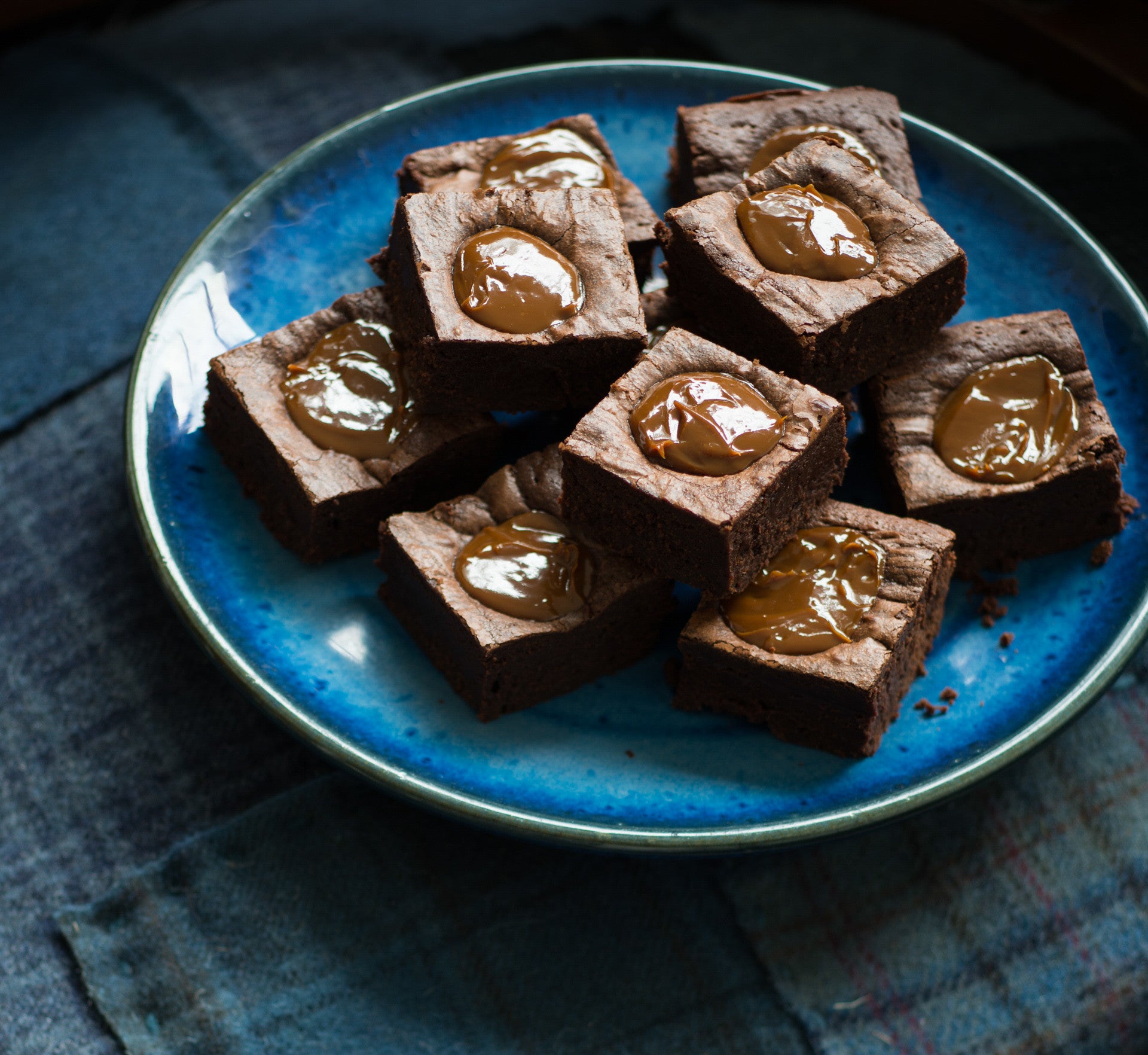
Prep 20min (+2hr cooling time)
Bake 30-35minMakes 15
Brownie lovers, take note: with every portion holding its very own generous dollop of dulce de leche, this is the brownie you have been searching for all your life! For a particularly wicked dessert, serve it drizzled with warmed extra dulce de leche and topped with a generous scoop of vanilla ice-cream.
Ingredients
Melted butter, to grease
250g (9oz) good-quality dark chocolate (45-54% cocoa), chopped
200g (7oz) salted butter, cubed
3 eggs, at room temperature, lightly whisked
165g (¾ cup, firmly packed/5¾oz) brown sugar
1½ teaspoons natural vanilla essence or extract
110g (¾ cup/4oz) plain flour
30g (¼ cup/1oz) cocoa powder
½ teaspoon baking powder
250g (9oz) jar dulce de leche
Cocoa powder or icing sugar (optional), to sprinkle
Method
- Preheat oven to 160°C/315°F (140°C/285°F fan-forced). Grease a 16cm x 26cm (6¼in x 10½in) shallow slice tin with melted butter and line the base and long sides with one piece of baking paper.
- Place the chocolate and butter in a medium heatproof bowl over a saucepan of gently simmering water (don't let the base of the bowl touch the water). Stir occasionally until chocolate and butter melt and the mixture is smooth. Remove bowl from saucepan and set aside.
- Use an electric mixer with a whisk attachment to whisk the eggs and sugar until thick and pale. Add the melted chocolate mixture and vanilla and whisk to combine.
- Sift together the flour, cocoa powder and baking powder. Add to chocolate mixture and whisk on low speed until just combined. Pour mixture into prepared tin and spread evenly with the back of a spoon.
- Dot the brownie mixture with spoonfuls of the dulche de leche, dividing evenly. Tap the tin on the benchtop to settle the mixture. Bake in preheated oven for 30-35 minutes or until moist crumbs cling to a skewer inserted in the brownie part. Remove from the oven and cool in tin on a wire rack (this will take about 2 hours).
- Remove brownie from the tin using the baking paper to lift it out. Cut into portions and sprinkle with cocoa powder or icing sugar to serve, if desired.
Baker's Tip
- These brownies will keep in an airtight container in the fridge, for up to 5 days. Serve at room temperature.
Photography by Alan Benson.






